Qualification for UEFA EURO 2020 brought an intriguing clash in Group I. Russia came into the game only three points behind the group leaders Belgium. A victory here, at home, was needed to maintain the chase for the top spot. Scotland were holding onto faint hopes of automatic qualification and needed an upset to keep those hopes alive.
This tactical analysis examines Russia’s comfortable 4-0 win. The analysis will focus on the tactics employed by the home side to claim such an emphatic result.
Lineups
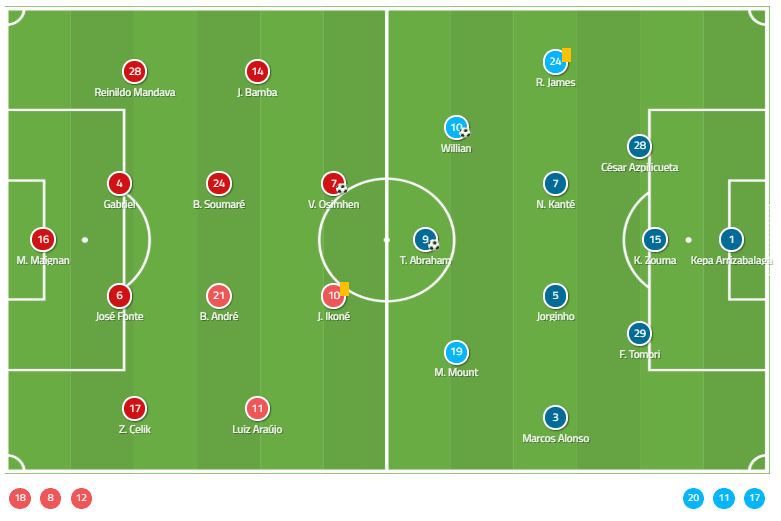
Stanislav Cherchesov set up the home side in 4-2-3-1 formation that often appeared as a 4-3-3. In goal, they had Guilherme Marinato with a backline of Mário Fernandes, Andrey Semenov, Georgiy Dzhikiya and Fedor Kudryashov. The double-pivot pair was Magomed Ozdoev and Dmitry Barinov. Aleksandr Golovin was in attacking midfield but would often drop in alongside the double-pivot pair to form a three. Out wide they had Aleksey Ionov and Yuri Zhirkov while Artem Dzyuba was the lone striker.
Steve Clarke sent out the visitors in an almost identical fashion to the hosts. Their 4-2-3-1 was backed up by David Marshall in goal. In front of him would be a defensive line of Liam Palmer, Michael Devlin, Charlie Mulgrew and Andy Robertson. Callum McGregor and John Fleck were the double-pivot with John McGinn ahead of them. Ryan Fraser and Robert Snodgrass would provide the width and Oliver Burke would spearhead the side.
Russia build-up structure
Russia were dominant in possession from the onset, pinning Scotland back almost immediately. The hosts finished the contest with 64% possession of the ball. They would build up with their full-backs pushed up very high, at times even ahead of all their midfielders. One of Ozdoev and Barinov would drop deep, at times slotting between the splitting central defenders.
These two had an impressive showing in their roles, circulating possession well and rarely looking in trouble with the ball. They were a key part in them ensuring such a high possession percentage without stagnating in the attack. Ozdoev even capped off his performance with a stunning long-range goal in the second half.
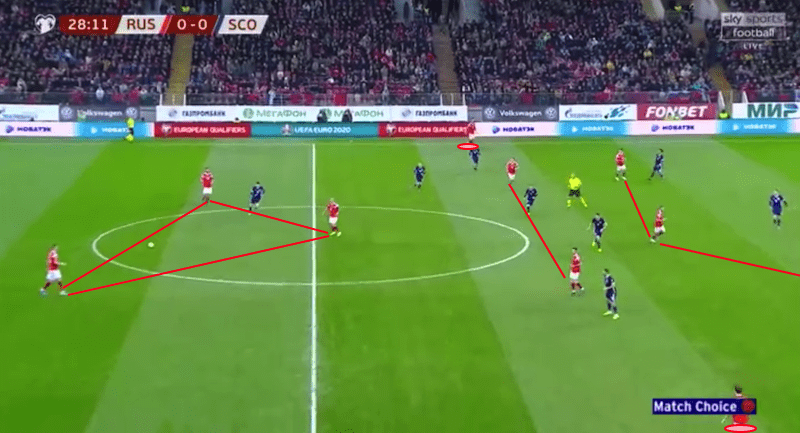
Golovin would either drop to join his fellow midfielders or roam the more advanced areas. To accommodate the high full-backs, the wingers would tuck in between the Scottish full-backs and centre-backs. They and Dzyuba would effectively occupy the entire Scotland backline, meaning other Scotland players had to deal with the fullbacks.
This became a problem for Scotland and their narrow defensive shape. As the game wore on, Russia started to exploit the gaps in midfield. They began to move the ball to more dangerous areas. This also contributed to the timidness of Scotland in defence, allowing Russia to dominate possession further.
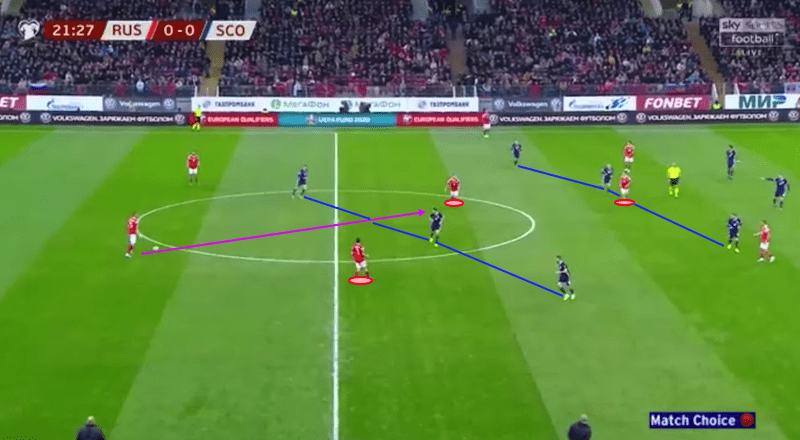
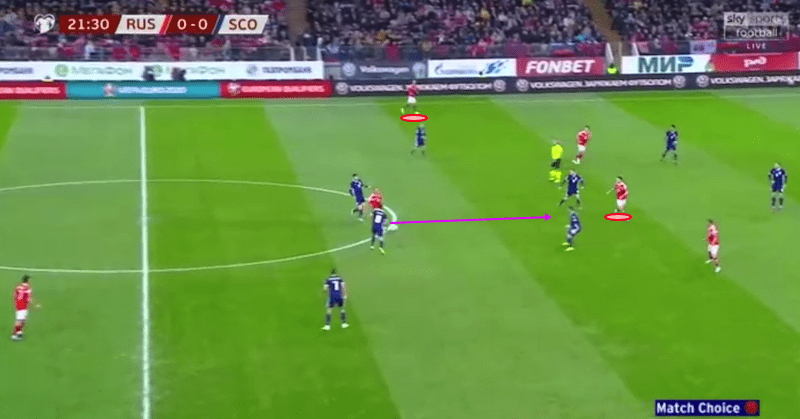
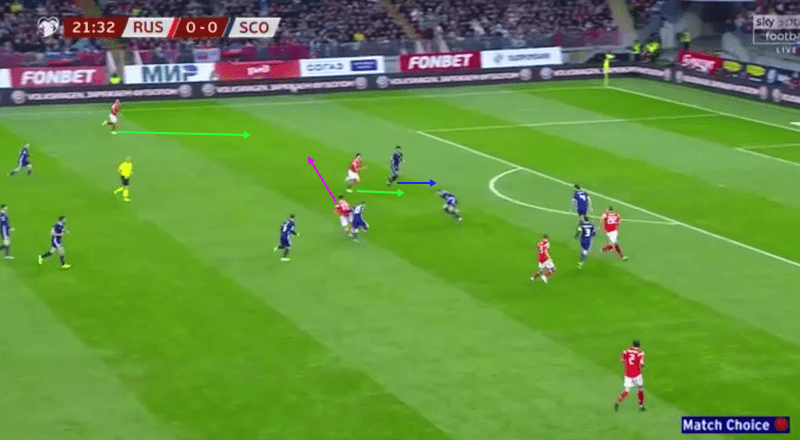
Scottish defensive setup
Scotland didn’t employ a high press but waited for Russia to play the ball wide to trigger the press. They did this out of a 4-3-2-1 shape with one of the attacking three behind Burke falling back into midfield. So for example, Scotland would have Fraser, Burke and Snodgrass as the first defensive line.
They wouldn’t press the Russian central defenders when they had the ball but didn’t drop back. This did leave gaps behind them but they positioned themselves well early on to block passing lanes to Russian midfielders. Instead, they would press any midfielders in and around them who would receive the ball. Russia would just play it wide and find central passing options between the lines from there.
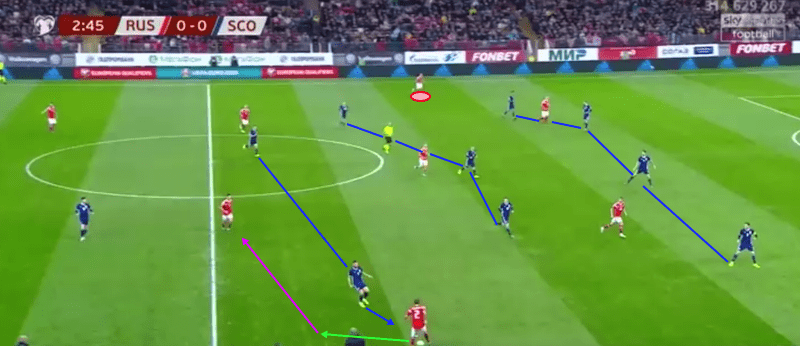
Having to deal with the Russian midfielders getting on the ball meant the Scottish midfielders had to stay narrow. They didn’t have the room to focus on tracking the opposition full-backs once Russia began to find players centrally. They had to leave at least one full-back completely free to adequately mark the Russian midfielders.
Scotland then seemed to use the 4-5-1 defensive setup more often with the Scottish wingers recovering deeper. This may have been due to the pressure coming from the Russian full-backs. This slight shift didn’t bring much change with the wide areas being a constant thorn in their side.
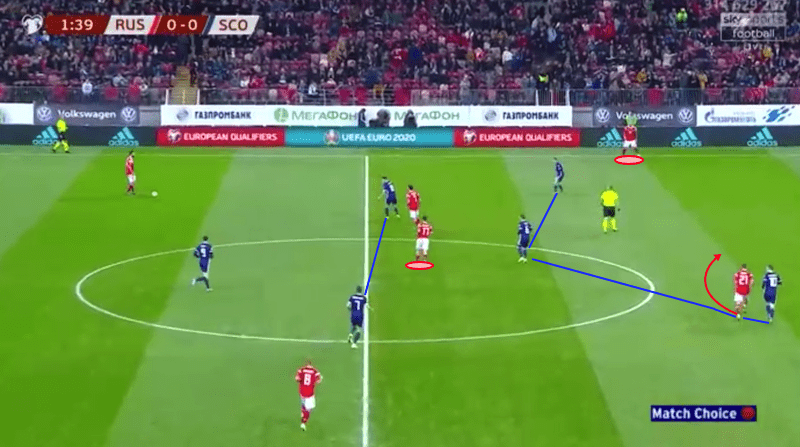
Dzyuba influence
Russia would then exploit the freedom of their full-backs constantly. From there they would look to either combine centrally or send in crosses. The crosses into the box were particularly a threat, especially with Dzyuba in such form. The frontman hassled the Scottish defence for much of the game with his imposing style of play. He would also drop to combine with the midfield, simultaneously creating gaps for his teammates’ runs behind Scotland.
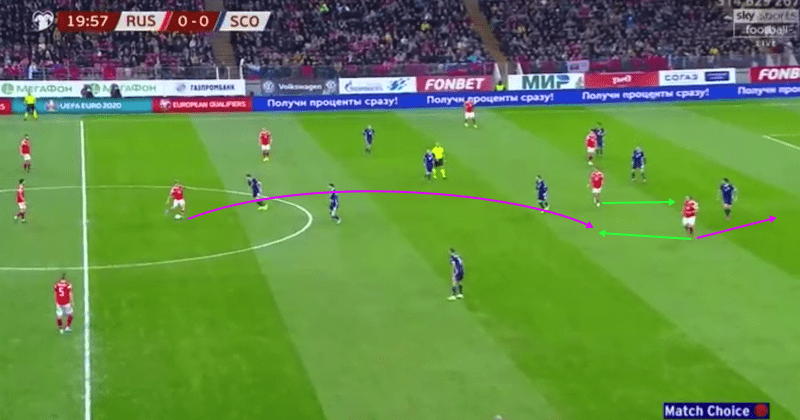
His brace and assist illustrated both the facets of his game. The striker opened the scoring, volleying in a Golovin corner with a Scottish defender draped all over him. He then grabbed his second after outbattling two defenders simultaneously and eventually poking the ball home. Dzyuba also showed a more skilful side to his game, trading short passes with Golovin in tight spaces, eventually teeing up the midfielder for his goal.
Scotland’s struggles going forward
Scotland only managed four shots during the entire game, the first of which they registered well into the second half. Those stats serve to highlight their offensive struggles during the game. With so little possession, Scotland’s primary routes to attack were the counter and playing it long. Neither of these posed a great danger to the Russians. They had the physical characteristics in the side to deal with most of the long balls.
Scotland would orientate their shape to one side and send the long ball to the crowded area where they’ll look to win second balls. Burke and his teammates did well to win some long balls and this did lead to some short spells of sustained possession. Unfortunately for Scotland, these moments were too short-lived for them to create anything.
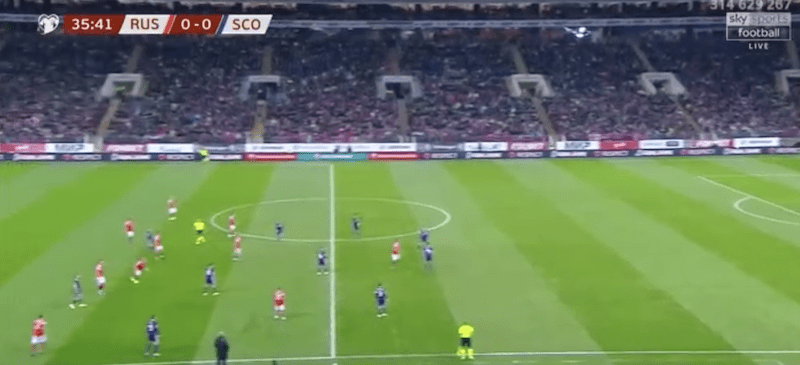
When they did keep the ball, they would have their double-pivot help the centrebacks play while the fullbacks pushed up. McGinn would switch between dropping to receive the ball and supporting Burke up top. Fraser and Snodgrass kept the width and would look for openings to send in crosses to Burke and supporting players.
Russia would settle into a 4-4-2 with the wingers moving beside the double-pivot while Golovin stayed alongside Dzyuba. These two would try to press to direct possession backwards, which would trigger a team press. This was a man-orientated press to try force a long ball and it was effective throughout the game.
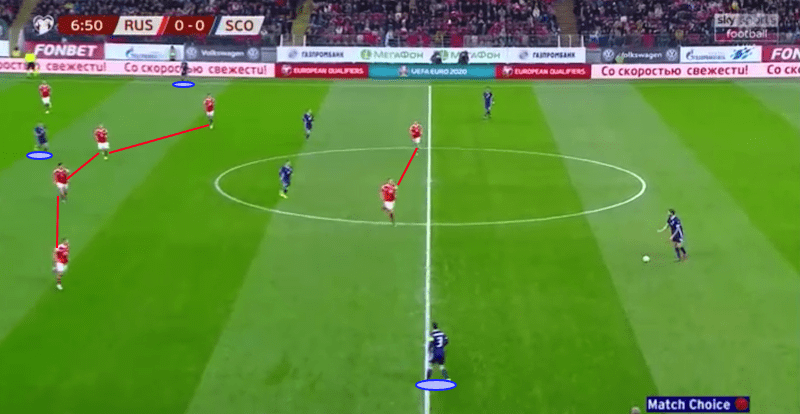
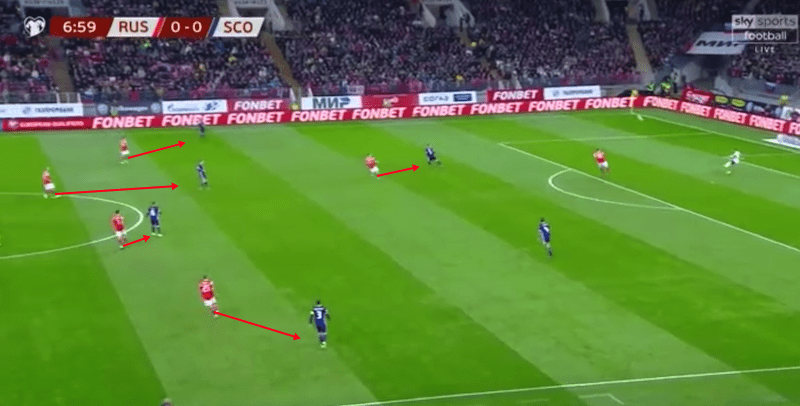
Scottish counter-attacking
Regarding their counter-attacking, Scotland were generally unable to win the ball in promising areas. And most of the times that they did, players were often left isolated, allowing Russia to recover in numbers and squash any threats. Their conservative nature was the likely reason that they couldn’t send reinforcements often enough.
But the counter-attacking tactic wasn’t completely ineffective. Scotland did find themselves in a few dangerous situations on the break but let themselves down with poor quality. They either failed to spot a pass or gifted the ball away with a poor touch or pass. Considering the infrequency of these opportunities, how they were wasted will hurt them most.
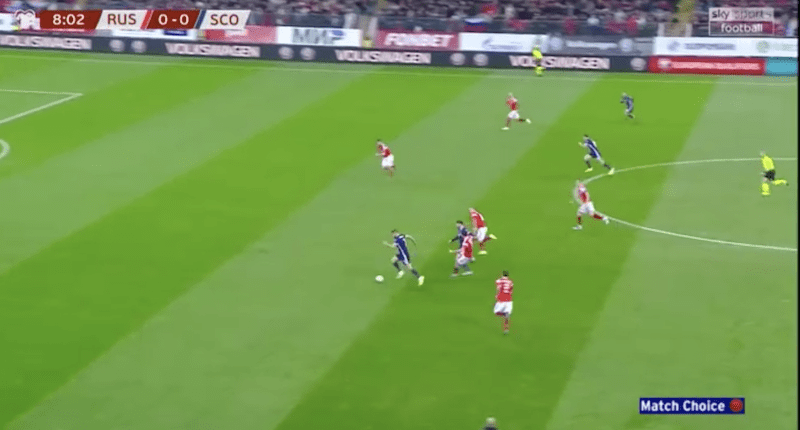
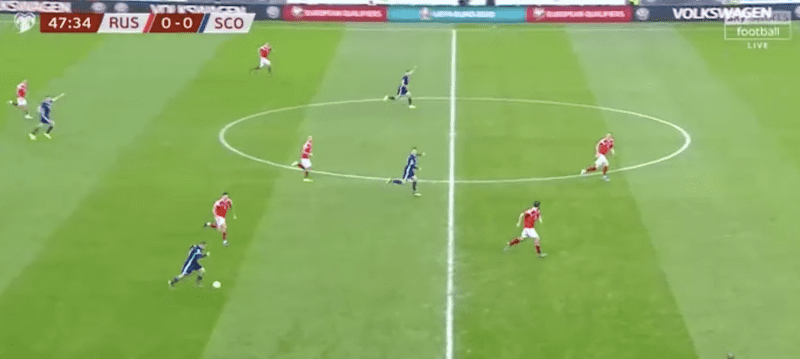
Conclusion
Russia may have taken a while to grab the lead but they were in full control of the game throughout. This was the expected performance as they maintained their ambition of topping the group. Scotland’s performance made it easier for Russia and puts an automatic qualification spot out of their reach. The away side will look to bounce back and will now focus on the hunt for a playoff spot. They host San Marino in a game they will undoubtedly need to win. Russia, on the other hand, go away to Cyprus to continue their impressive campaign thus far.
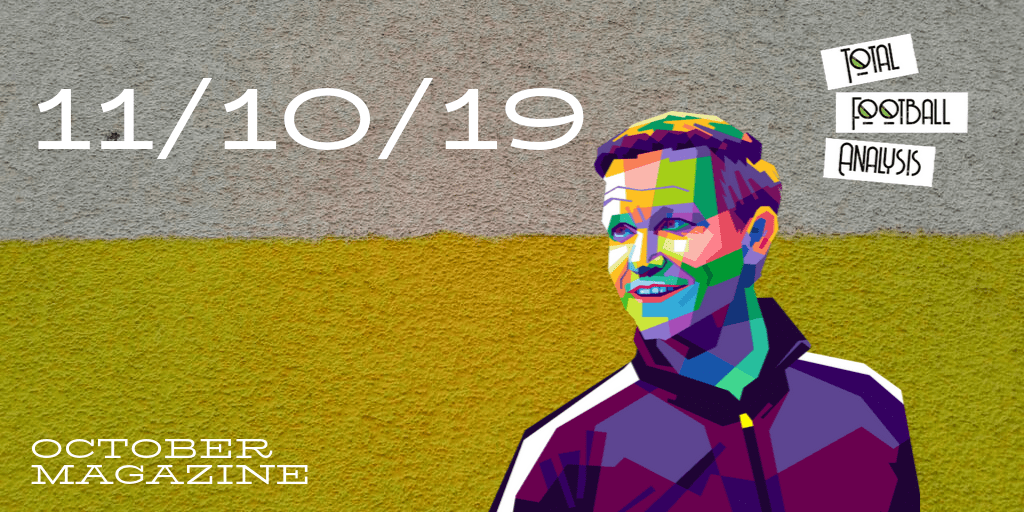
If you love tactical analysis, then you’ll love the digital magazines from totalfootballanalysis.com – a guaranteed 100+ pages of pure tactical analysis covering topics from the Premier League, Serie A, La Liga, Bundesliga and many, many more. Buy your copy of the October issue for just ₤4.99 here

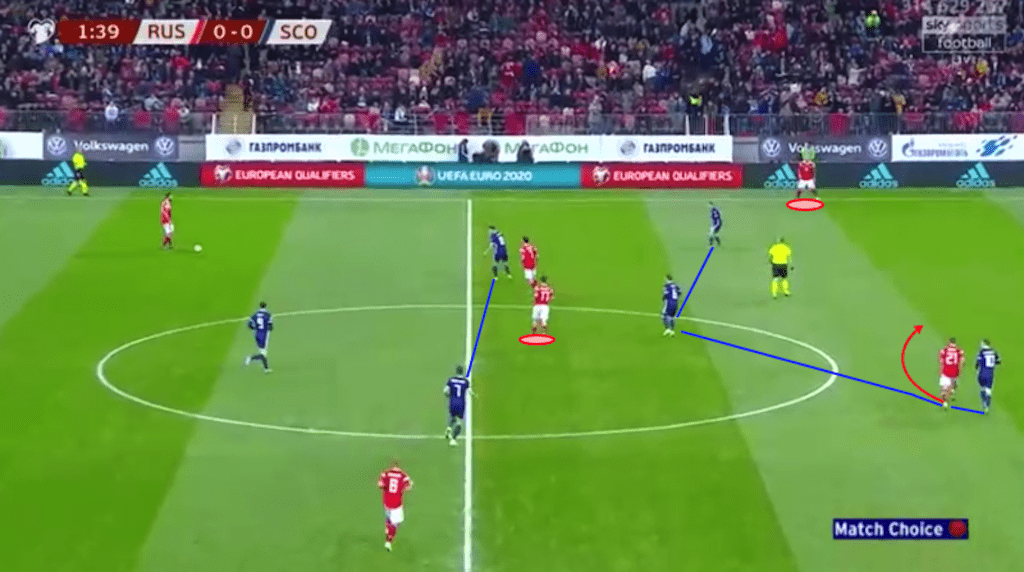




Comments